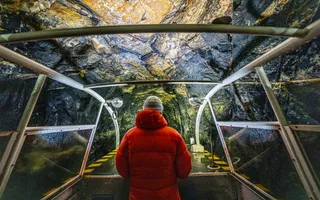Tunnels and culverts are an integral part of our network, providing a rare window into our past and presenting a unique maintenance challenge. Peter Simpson tells us more about these vital structures.
Peter Simpson is our principal engineer for tunnels and culverts. For the uninitiated, culverts are typically, although not always, large brick and stone structures that run underneath our canals, conveying watercourses and utilities. Peter heads up a specialist team that inspects, manages and maintains more than 50 tunnels and 2,000 culverts across our network. We caught up with him to learn more about their importance, their history, and exactly what it takes to keep them operational.
Just like bridges and locks, tunnels and culverts are a big part of our infrastructure, and as Peter explains, tunnels, in particular, are inextricably linked to the history of our canals: “Aside from mining, some of the very first tunnels ever constructed were canal tunnels. The vast majority were built before the first railway tunnels and the first road tunnels, so effectively, canal engineering pioneered tunnelling as we know it today.”
With little historical precedent, early tunnel engineers had to rely on ingenuity, imagination and dogged determination. “They were dealing with a lot,” says Peter, “encountering different ground conditions, having to employ different techniques, and having to adapt as they went. Tunnelling has always been inherently dangerous, and back then, there were a lot of unknowns. There was very little concern for health and safety, and unfortunately, people lost their lives.”
Despite massive logistical challenges, harsh conditions, and the very real threat of injury and death, the brave navvies who carved out those first tunnels stuck stoically to their task. “There was a lot of trial and error,” says Peter, “and considering most of the men who carried out the boring and blasting had little or no formal training, their work was extremely impressive, and it’s left us with some really robust structures.”
As accomplished as those early pioneers were, many of the tunnels they built are now more than 200 years old and constructed using outdated methods and materials. It’s up to Peter and his team to keep them safe, open, and properly maintained.
“It’s a unique challenge,” says Peter. “Take Standedge Tunnel, for instance. You’ve got nearly every construction material known to man popping up in different places within the tunnel, with lovely brickwork alongside these impressive natural rock sections. And then you’ve got structures like Islington Tunnel, which goes through London Clay, which is notorious for swelling, so they put in this big timber framework. As you can imagine, all this variation adds to the complexity of managing and inspecting the tunnels.”
There’s no doubt it's a complicated, painstaking process, but it’s imperative to the health of our canals and the welfare of the people who use them. “If things go wrong, they have the potential to go spectacularly wrong,” says Peter, referring to an incident in the early 1980s, when a tunnel collapsed on the Trent & Mersey Canal. Thankfully, no lives were lost, however, in order to repair the damage, maintenance teams had to demolish a private residence.
“Nowadays, we take a proactive approach to the management of our tunnels undertaking regular inspections with some even receiving regular monitoring,” says Peter. It’s a stark reminder of just how important people like Peter are in maintaining our canal system and keeping visitors safe.
It’s not just our tunnels that Peter and the team oversee; they’re also responsible for more than 2,000 culverts across our network. “Culverts aren’t sexy,” laughs Peter, “so they’re a bit of a harder sell; but make no mistake, they’re just as important to our network as tunnels. They have a big impact on our canals, causing lots of stoppages every year, so again, it’s crucial we keep them properly maintained.”
More than 27 miles of our network is underground, and with an ageing infrastructure and a changing climate, the work Peter and the team do, though often unseen, is vitally important. So next time you’re walking along your local towpath, give a thought to what’s going on right beneath your feet.








